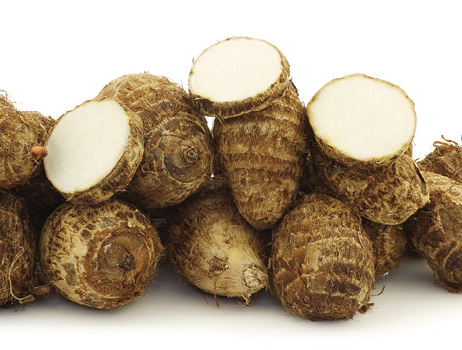Water Taro | Colocasia esculenta
Emergent | Non-Native



Water taro is a non-native, water-tolerant plant that can grow and survive in water up to 1 foot deep. This species is native to Asia but has been introduced to multiple countries globally for ornamental use and as a food crop.
The leaves grow from long stalks and are arrowhead-shaped, very large (up to 3 feet long), and dark green. It is often called “elephant ear” due to its resemblance and size. Stems are up to 4 feet long and grow from large rhizomes.
Taro is an important root vegetable and is cooked much like potatoes in many countries. It is often boiled, baked, mashed, or sliced thin and made into a snack chip.
Management Value
Water taro is an attractive garden and ornamental pond species. It has a tropical appearance that many landowners desire. The tubers are popular as a human food when prepared correctly, which generally involves a quick boil followed by a slow simmer submersed in water in a covered pot.
This species provides little wildlife value; on the contrary, it tends to disrupt natural ecosystems and displace native species. Water taro can be invasive to riparian habitats and shallow waters. It should be eradicated upon first detection.
Recommended Controls
Option 1: 2,4-D (3.8-pound formulation). For each gallon of water, mix 1.28 ounces 2,4-D and 1.3 ounces non-ionic surfactant. Spray to wet all plants. Do not exceed annual herbicide rate limits as stated on the product label.
Option 2: Triclopyr (3.0-pound formulation). For each gallon of water, mix 1.28 ounces triclopyr and 1.3 ounces non-ionic surfactant. Spray to wet all plants. Do not exceed annual herbicide rate limits as stated on the product label.
Option 3: Glyphosate (5.4-pound formulation). For each gallon of water, mix 1.28 ounces glyphosate and 1.3 ounces non-ionic surfactant. Spray to wet all plants. Do not exceed annual herbicide rate limits as stated on the product label.
Multiple applications will likely be needed to achieve eradication; combining any two of the listed herbicide treatments may enhance control.
Read and follow all chemical label instructions, especially the section on the use of personal protection equipment.

The information given here is for educational purposes only. References to commercial products, trade names, or suppliers are made with the understanding that no endorsement is implied and that no discrimination against other products or suppliers is intended.
Publication 3735-39 (POD-11-23)
By Wes Neal, PhD, Extension/Research Professor, Wildlife, Fisheries, and Aquaculture; Dennis Riecke, Fisheries Coordinator, Mississippi Department of Wildlife, Fisheries, and Parks; and Gray Turnage, PhD, Assistant Research/Extension Professor, GeoSystems Research Institute.
Copyright 2023 by Mississippi State University. All rights reserved. This publication may be copied and distributed without alteration for nonprofit educational purposes provided that credit is given to the Mississippi State University Extension Service.
Produced by Agricultural Communications.
The Mississippi State University Extension Service is working to ensure all web content is accessible to all users. If you need assistance accessing any of our content, please email the webteam or call 662-325-2262.



